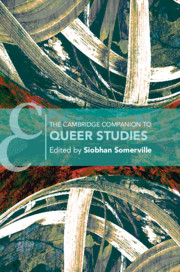Book contents
- The Cambridge Companion to Queer Studies
- The Cambridge Companion to Queer Studies
- Copyright page
- Dedication
- Contents
- Figures
- Contributors
- Acknowledgments
- Chronology
- Introduction
- Part I Genealogies
- Part II Confluences
- Part III Representation
- Chapter 8 Queer Poetics
- Chapter 9 Queer Narrative
- Chapter 10 Trace a Vanishing, or Queer Performance Study
- Chapter 11 Queer and Trans Studies in Pop Culture
- Chapter 12 Queer Digital Cultures
- Part IV Key Words
- Index
- Cambridge Companions to …
- References
Chapter 9 - Queer Narrative
from Part III - Representation
Published online by Cambridge University Press: 02 June 2020
- The Cambridge Companion to Queer Studies
- The Cambridge Companion to Queer Studies
- Copyright page
- Dedication
- Contents
- Figures
- Contributors
- Acknowledgments
- Chronology
- Introduction
- Part I Genealogies
- Part II Confluences
- Part III Representation
- Chapter 8 Queer Poetics
- Chapter 9 Queer Narrative
- Chapter 10 Trace a Vanishing, or Queer Performance Study
- Chapter 11 Queer and Trans Studies in Pop Culture
- Chapter 12 Queer Digital Cultures
- Part IV Key Words
- Index
- Cambridge Companions to …
- References
Summary
Narrative theory has been used extensively by queer theorists to reconceptualize the cultural workings of sex, gender, and sexuality, not to mention race, nation, indigeneity, and class, among other key categories. This chapter provides an overview of some queer renderings of narrative. The chapter focuses on the interconnections between narrative, sexuality, modernity, and colonialism before considering some dominant narrative genres and queer critical engagements with these: the transition autobiography, the coming out narrative, and the “progress” narrative, explored at the level of the individual and of the collective and historical. The chapter concludes with an analysis of the uses of some of these narrative forms in the 2015 same-sex marriage referendum in the Republic of Ireland.
Keywords
- Type
- Chapter
- Information
- The Cambridge Companion to Queer Studies , pp. 142 - 155Publisher: Cambridge University PressPrint publication year: 2020
References
Further Reading
- 1
- Cited by



